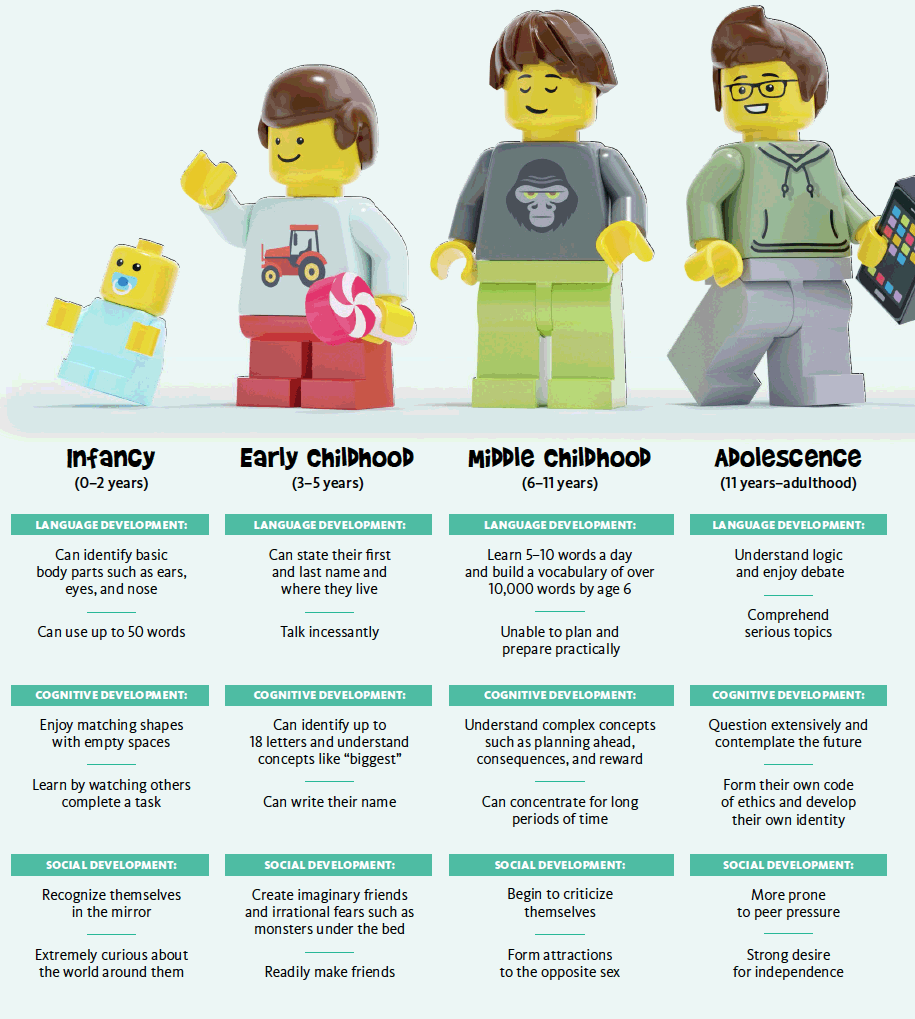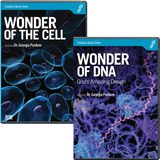Playing by Different Rules
Kids don’t just play differently from adults, they think differently too—by God’s design. Scientists are learning that their brains and bodies run by their own special rules, performing feats adults can’t match.
One summer break during college, I worked at a Christian camp. The fourth-grade girls I cared for couldn’t get enough kickball, playing nonstop in the blazing sun for three hours every day. When it was time for a water break, they gulped down their drinks and dashed back to play. I, on the other hand, was more interested in taking a long nap. The constant activity wore me out.
One day as I rested under the shade of a tree watching the kids play, I reminisced about how I once had the same energy and carefree attitude. Then it hit me. God intentionally made kids very different from adults.
Kids are typically lighthearted, energetic, unaware of time, and amused by the smallest thing. In contrast, adults worry constantly, lack energy, watch the clock, and find it difficult to laugh about simple things. It’s not hard to see how differently kids act and think. Even Scripture acknowledges a clear distinction. “When I was a child, I spoke like a child, I thought like a child, I reasoned like a child. When I became a man, I gave up childish ways” (1 Corinthians 13:11).
Far from shortcomings, the differences in kids are by design, appropriate to their stages in life.
Far from shortcomings, these differences are by design, appropriate to their stages in life. According to the Old Testament, children are “fearfully and wonderfully made” (Psalm 139:13–16) and a “heritage from the Lord” (Psalm 127:3). They are special in their own right. Said another way, God made all of us cool kids from the start. Modern research is just now beginning to uncover how children can perform feats grown-ups can only dream about.
Let’s Start with Babies
If we’re going to talk about cool kids, we need to start with babies. We all were once tiny, squirmy humans who filled our diapers, cried, and fought sleep. Through those many long nights, our parents probably didn’t realize that something special was going on inside our brains.
Researchers have been studying babies for decades to discover their secrets. It appears their brains really do work differently from ours. Experts in artificial intelligence (AI) are taking a closer look too. If they could design a computer that mimics a baby’s brain, perhaps it could make intuitive leaps that modern binary computers never could.
Deb Roy and his wife Rupal Patel aren’t your run-of-the-mill parents. Deb (yes, it’s a common guy’s name in India) is an AI and robotics expert at the Massachusetts Institute of Technology (MIT), and Rupal is a well-known speech and language specialist at Northwestern University. Before they had children, Deb boasted to his wife that his latest robot—with his innovative image-recognition software—could learn just like a child, simply by watching videos and connecting objects to sounds.
As soon as they brought their son home in 2005, they commenced the Human Speechome Project, gathering surveillance videos that Deb could feed to his robot. For three years, he collected over 90,000 hours of video and 140,000 hours of audio.
Where is all this footage now? It’s collecting dust in the couple’s basement. Here’s why: Deb, the mastermind behind the project, realized a traditional robot could never match the intelligence of his son.
Deb first realized he was in trouble the day his son tried to say an actual word. Following his father’s gaze, the boy looked directly at a picture of a fish and said, “Fah.” He then looked at his father with a knowing look, confirming that he got it right. “He’s not even a year old,” Deb acknowledged, “but there’s a conscious being.”
That day, Deb accepted that no matter how hard he tried to give it human qualities, his robot could only mimic the most superficial aspects of a child’s intelligence. A child learns in a continuous, conscious way, observing the world and comparing it to feedback from his parents and other conscious beings around him.
AI leaders in this new research suspect that babies benefit from running two mental processes at the same time. They are born with a powerful set of basic logical concepts and wiring to begin running these “rules,” which help them crunch the numbers as they gather tons of data from the world around them.
Computers, on the other hand, just do number crunching. For example, if babies see a dachshund for the first time, they instantly know it seems to be a “dog” even if all they’ve known was their family’s St. Bernard. Computers, however, must compare tens of thousands of dogs to extract the basic traits that define a dog.
AI researchers have started several initiatives worth hundreds of millions of dollars to explore the possibilities of a new kind of computing, such as a $125 million effort by the Allen Institute for Artificial Intelligence. MIT psychologist Josh Tenenbaum told Science, “We’re trying to take one of the oldest dreams of AI seriously: that you could build a machine that grows into intelligence the way a human does—that starts like a baby and learns like a child.”
Indeed, we now know that babies begin learning inside the womb, long before their first cries. A new study suggests that when babies kick in utero, they are already constructing a brain network to understand which part of their body is moving. They use this framework to begin putting together the streaming data from their ever-changing world into a coherent picture.
A Different Body Plan

Adults are taller, children are shorter. Adults are stronger, children are weaker. It’s easy to notice the obvious differences, but have you ever stopped to think about the subtler ones? Turns out, God designed kids with many surprising differences.
Taste Buds
Children are born with 10,000 taste buds, double the number in adults. Babies are born preferring sweet-tasting food, the flavor of mother’s milk with lots of glucose needed for growth. As their taste buds lose sensitivity with age, kids can tolerate bitter tastes like brussels sprouts.
Weight Loss
Due to high physical activity, children often have a higher metabolic rate (rate of burning calories). They also have more “brown” fat that is good at burning calories to produce heat.
Rapid Learning
A baby’s brain is constantly soaking up new information. Starting with 100 billion neurons (as many as adults have) it constantly adds new connections (synapses). By age one, the number of synapses peaks and then decreases as the brain purges the weaker connections.
Hearing
Kids can detect sounds at higher and lower frequencies than adults. Babies can also listen to all frequencies simultaneously. Eventually, they learn to focus on what is pertinent (like the friendly adult in a crowd offering candy).
Larger Body Surface Area
The ratio of skin to size is much larger for kids, so they cool down faster. That’s why kids can catch a chill or dehydrate when adults feel fine.
Babies also learn to recognize individual voices in utero. Within one hour after birth, they can distinguish familiar voices (like mom’s) that they’ve been listening to in the womb. The Bible records just how smart babies are: John the Baptist leapt in his mother’s womb when he heard Mary’s greeting (Luke 1:41). Our Creator makes sure even the tiniest humans can learn about him. His concern for babies reminds us how much he values human life at every stage—and how cool kids really are.
Wired Differently
Can you imagine going back to kindergarten? Sitting at a desk all day, cutting out shapes with craft scissors, and gluing macaroni to construction paper. There’s a reason this sounds like torture. Kids learn differently than adults. They need lots of repetition and experimentation.
Yet they’re really good at learning. Children are wired to record and connect loads of information automatically without consciously thinking about it. And it sticks.
In a 2017 report, researchers at The Ohio State University showed 35 adults and 34 four- and five-year-olds a computer screen with two overlapping shapes. The participants were asked to pay attention to one shape each time the screen changed. While the adults observed the changes in the one shape they were focusing on, they missed the changes in the other shape. The children, on the other hand, noticed the changes in both shapes. Their inability to stay focused on just one thing and collect lots of information at once was a strength in this instance.
Vladimir Sloutsky, coauthor of the study, explained, “The point is that children don’t focus their attention as well as adults, even if you ask them to. The ability to focus attention is what allows adults to sit in two-hour meetings and maintain long conversations while ignoring distractions. But young children’s use of distributed attention allows them to learn more in new and unfamiliar settings by taking in a lot of information.” Perhaps this is why even the slightest prompting can help you recall a nursery rhyme you learned as a kid.
Even learning a new language is easy for children. They don’t have to work at it like we do. The millions of brain cells responsible for their speech continuously create new circuits before age 10. But once children complete puberty, their brain functions differently. That’s why it’s harder for you to learn a new language. One study at Washington University in St. Louis, Missouri, confirmed that our brains reorganize themselves as we age.
This shouldn’t come as a surprise. If you put a child and an adult in the same room with a cardboard box and ask them to decide how to use the box, the adult would think of practical uses for the box. But a child would see the box as their next spaceship or race car or whatever they could imagine. Until a certain age, children can’t distinguish the difference between fantasy and reality; in turn, they are unable to quickly distinguish between true and false information. Perhaps this is why Jesus so adamantly condemned anyone who would offend or lead a child astray (Luke 17:2). He knew they were susceptible to being manipulated and incapable of logical judgment. As we age, our brain continues to grow and mature. If the Creator hadn’t designed us to grow, we might still enjoy finger painting every day.
Processing the World Differently
Children process the world differently at each developmental stage. If you ask a baby his name, he might let out a few coos, but you don’t expect an intelligible answer. A toddler may know his name but won’t know why his parent chose it. An adolescent will know why and might even question the choice. Each stage reflects a necessary step in God’s design for growing us into mature adults who know and serve him.

Endless Supply of Energy
All this “mapping of the world” and building a mental library from scratch takes energy—lots of it. A healthy child is a busy child, filling his days with rich experiences. And God has that need for speed covered too.
If you’ve spent any time with kids, you’ve noticed that they never seem to run out of energy. Ongoing research shows that their endurance rivals that of top athletes. Let’s pause here for a moment. Bo Jackson, former NFL running back, once ran 40 yards in 4.13 seconds. Sound impressive? It also sounds quite exhausting. It takes a long time for adults to recuperate before their next run. But kids have more energy and resilience than world-class athletes!
To test this point, researchers at a French university gathered 12 children between the ages of nine and eleven, 12 untrained men, and 13 male athletes. Everyone was asked to complete two 7-second sprints that included a 1-minute recovery time. While the adults, including the trained athletes, needed extra rest time, the kids were ready to continue almost immediately.
Kids need a proper diet and exercise to stay fit, but the Creator gave them an advantage. He designed children’s bodies to use muscles and burn fat differently from adults. We have two basic kinds of muscle fibers, one for long-term, low-intensity activities like jogging (type I), and one for short-term, high-intensity activities like sprinting (type II). It gets complicated, but kids basically use the low-intensity muscles to do most of the work, including high-intensity activity like sprinting. So the brain doesn’t register fatigue like it does for adults. Kids can pick up their kickball and dash around the bases another time with little rest in between.
Their metabolism also follows different rules. Adult bodies have a way to get energy for normal, everyday activities like jogging (aerobic metabolism) and another way to insert extra energy for the short-term like sprinting (anaerobic metabolism). Kids rely more on the aerobic metabolism for both everyday tasks and special tasks. Consequentially, they never seem to get tired.
A Considerate Creator
Our Creator makes sure even the tiniest humans can learn about him. His concern for babies reminds us how much he values human life at every stage—and how cool kids really are.
In the New Testament, some parents brought their children to Jesus so he could pray for them. The disciples tried to turn them away, but Scripture says Jesus was “indignant” and said, “Let the children come to me; do not hinder them, for to such belongs the kingdom of God. Truly, I say to you, whoever does not receive the kingdom of God like a child shall not enter it” (Mark 10:14–15). During Jesus’ time, children weren’t seen as equals. The disciples thought Jesus shouldn’t be troubled with children, since they weren’t worthy of his time. But Jesus accepted them with loving arms.
Christ was, after all, their Creator. He made them in a special way because he loved them and knew their needs and wanted to meet them. Jesus knew we all have something to learn from children. In fact, his kingdom belongs to those who have the best qualities of children (Matthew 19:14). They are lighthearted, trusting, and energetic. The same Creator who supplies each child’s needs also provides adults with everything they need to enjoy an abundant life, which begins with simple childlike faith in their Creator and Redeemer.
Answers Magazine
July–August 2019
When we consider fossils and extinct creatures, the ark surely contained many animals we would not normally consider. What animals were—and weren’t—on the ark?
Browse Issue SubscribeRecommended Resources

Answers in Genesis is an apologetics ministry, dedicated to helping Christians defend their faith and proclaim the good news of Jesus Christ.
- Customer Service 800.778.3390
- © 2024 Answers in Genesis





